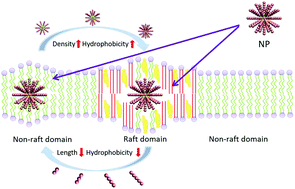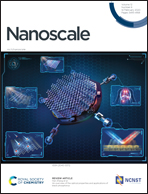Optimization of hydrophobic nanoparticles to better target lipid rafts with molecular dynamics simulations†
Abstract
Due to different interactions between lipids and proteins, a plasma membrane can segregate into different membrane domains. Among them, ordered functional membrane domains are defined as “lipid rafts”, which play key roles in many biological processes (e.g., signal transduction, endocytosis, etc.) in the cell. Hence, it will be of much biological significance to monitor and even regulate the dynamics of lipid rafts. In this work, we designed a ligand-modified spherical nanoparticle with coarse-grained molecular dynamics simulations, which can be encapsulated into the hydrophobic region of the lipid membrane and specifically target either raft or non-raft membrane domains. The preferred localization of the nanoparticle can be tuned by adjusting ligand hydrophobicity, length and density. Generally, more hydrophobic nanoparticles tend to target the raft domain, while less hydrophobic nanoparticles prefer the non-raft domain. Besides, ligand length and density jointly determine the exposure of nanoparticle cores and thus affect the roles of ligands in nanoparticles’ final localization. Our results may provide insights into the experimental design of functional nanoparticles, targeting the lipid raft and regulating its dynamics.

- This article is part of the themed collection: Theoretical Modelling at Nano-bio Interfaces


 Please wait while we load your content...
Please wait while we load your content...